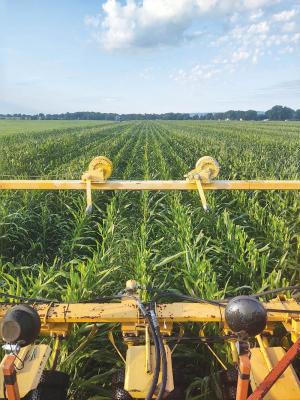Nutrient Rich Corn Produces Its Own Nitrogen
 ✖  |
Foundation Direct has Nutrient Rich Corn (NRC) seed with more protein than #2 yellow corn and more oil, carotene, methionine, and lysine, as well as micronutrients like manganese, boron, iron, copper and zinc. To top it off, it even fixes some nitrogen. There’s only one problem, according to Steve Mohr, Foundation Direct Seed and Foundation Organic Seed.
“It has about 15 percent yield drag,” says Mohr. “We have new genetics that we’ll be introducing that will yield within 5 to 10 percent of standard hybrids.”
Even with the yield drag, the NRC may prove to be worth as much per acre in nutrients as a higher-yielding variety. In addition to 5 to 10 percent more protein, it has 40 to 55 percent more carotene, known for giving egg yolks a deeper orange color and a beneficial antioxidant for humans and animals.
Even more interesting for many farmers is the corn’s limited ability to fix nitrogen. It’s estimated that it produces about half the nitrogen it needs for maximum yield.
“It doesn’t produce enough nitrogen for a 170 bushel per acre crop,” says Mohr. “However, without supplemental nitrogen, it does about 100 bushels per acre. If your goal is to grow corn without off-the-farm inputs, it might be a good option.”
Foundation Organic Seed had four of the NRC hybrids listed in their 2023 catalog. He’s unsure, as yet, if any of the NRC seed will be available until 2025 as he introduces the new genetics.
Mohr has the exclusive rights to germplasm developed by Walter Goldstein, Mandaamin Institute. Goldstein has long worked to develop nutrient-rich, open-pollinated corn. After an ancient landrace corn that fixed nitrogen was discovered in Chile, he founded the Mandaamin Institute to develop it and other open-pollinated grains.
To boost yield levels, Goldstein has switched from open-pollinated lines to single cross hybrids.
“Walter is redoing the parent lines of the hybrids we’ve been working with,” explains Mohr. “This year, we plan to grow the males and females. In 2024 we’ll cross them to produce hybrid seed for farmers in 2025.”
He says these unique hybrids will be well suited for a select type of farmer and farm operation. “Extensive testing by several universities has helped determine where these hybrids fit and where they don’t,” says Mohr.
He remains optimistic that the NRC lines will continue to improve in yield and hopefully in their ability to fix nitrogen.
Contact: FARM SHOW Followup, Foundation Organic Seed, 634 13th Ave. N, Onalaska, Wis. 54650 (ph 608-780-5460; smohr5@charter.net; www.foundationorganicseed.com).

Click here to download page story appeared in.
Click here to read entire issue
Nutrient Rich Corn Produces Its Own Nitrogen CROPS New Crops Foundation Direct has Nutrient Rich Corn NRC seed with more protein than #2 yellow corn and more oil carotene methionine and lysine as well as micronutrients like manganese boron iron copper and zinc To top it off it even fixes some nitrogen There’s only one problem according to Steve Mohr Foundation Direct Seed and Foundation Organic Seed “It has about 15 percent yield drag ” says Mohr “We have new genetics that we’ll be introducing that will yield within 5 to 10 percent of standard hybrids ” Even with the yield drag the NRC may prove to be worth as much per acre in nutrients as a higher-yielding variety In addition to 5 to 10 percent more protein it has 40 to 55 percent more carotene known for giving egg yolks a deeper orange color and a beneficial antioxidant for humans and animals Even more interesting for many farmers is the corn’s limited ability to fix nitrogen It’s estimated that it produces about half the nitrogen it needs for maximum yield “It doesn’t produce enough nitrogen for a 170 bushel per acre crop ” says Mohr “However without supplemental nitrogen it does about 100 bushels per acre If your goal is to grow corn without off-the-farm inputs it might be a good option ” Foundation Organic Seed had four of the NRC hybrids listed in their 2023 catalog He’s unsure as yet if any of the NRC seed will be available until 2025 as he introduces the new genetics Mohr has the exclusive rights to germplasm developed by Walter Goldstein Mandaamin Institute Goldstein has long worked to develop nutrient-rich open-pollinated corn After an ancient landrace corn that fixed nitrogen was discovered in Chile he founded the Mandaamin Institute to develop it and other open-pollinated grains To boost yield levels Goldstein has switched from open-pollinated lines to single cross hybrids “Walter is redoing the parent lines of the hybrids we’ve been working with ” explains Mohr “This year we plan to grow the males and females In 2024 we’ll cross them to produce hybrid seed for farmers in 2025 ” He says these unique hybrids will be well suited for a select type of farmer and farm operation “Extensive testing by several universities has helped determine where these hybrids fit and where they don’t ” says Mohr He remains optimistic that the NRC lines will continue to improve in yield and hopefully in their ability to fix nitrogen Contact: FARM SHOW Followup Foundation Organic Seed 634 13th Ave N Onalaska Wis 54650 ph 608-780-5460; smohr5@charter net; www foundationorganicseed com
To read the rest of this story, download this issue below or click
here to register with your account number.







